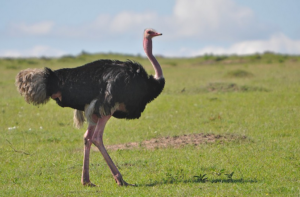The Common Ostrich | The World’s Largest Bird
The Common Ostrich | The World’s Largest Bird : is the world’s largest bird and fastest runner of any bird. Lacking teeth, ostriches swallow pebbles to grind their food and an adult ostrich carries about 1kg of stones at any time. Generally, they can sprint at over 70 km/hour, covering up to 5m in a single stride.
 Their running is aided by having just two toes on each foot with the large nail on the larger, inner toe resembling a hoof. When threatened, the ostrich will either hide itself by lying flat against the ground or run if concerned. Although they are powerful, long legs can be formidable weapons. They are therefore capable of killing a human or a potential predator like a lion with a forward kick. Additionally, its feathers are decorative and are also used as feather dusters. Its skin is also used for leather products and its meat is marketed commercially.
Their running is aided by having just two toes on each foot with the large nail on the larger, inner toe resembling a hoof. When threatened, the ostrich will either hide itself by lying flat against the ground or run if concerned. Although they are powerful, long legs can be formidable weapons. They are therefore capable of killing a human or a potential predator like a lion with a forward kick. Additionally, its feathers are decorative and are also used as feather dusters. Its skin is also used for leather products and its meat is marketed commercially.
Ostrich facts
Appearance
The feathers of adult males are mostly black, with white primaries and a white tail. The long neck and legs keep their head up to 2.8 m (9 ft) above the ground. More so, their eyes are said to be the largest of any land vertebrate helping them to see predators at a great distance. However, the head and bill are relatively small for the birds’ huge size. Their skin also varies in color depending on the subspecies. Some are having light or dark gray skin while others have pinkish or even reddish skin. The strong legs of the common ostrich are unfeathered and show bare skin with the tarsus being covered in scales.
Diet
The Ostrich is one of the world’s largest omnivores, consuming both plants and animals. Sometimes they also feed on invertebrates though and they lack teeth. However, they mainly feed on seeds, shrubs, grass, fruit as well as flowers. In addition, they swallow pebbles that act as gastroliths to grind their food in the gizzard. Interestingly, an adult ostrich carries about 1kg of stones in its stomach. Ostriches that live in captivity such as zoos have very different food sources than their wild counterparts. On the other hand ostriches that live in captivity often consume diets full of components. These include; alfalfa, hay, commercial pellets, grains and fresh vegetables.
Breeding
They generally have wings that reach a span of about 2metres used in mating displays. These are also used to shade chicks, to cover the naked skin of the upper legs and flanks to conserve heat, etc. Ostriches perform a complex mating ritual consisting of the cock alternating wing beats until he attracts a mate. Afterwards, they will go to the mating area and he will drive away all intruders. The cock will then excitedly flap alternate wings again, and starts poking on the ground with his bill. He will then violently flap his wings to symbolically clear out a nest in the dirt. While the hen runs circle around him with lowered wings, he will wind his head in a spiral motion. She will later drop to the ground and he will mount for copulation.
Behavior
As a matter of fact, these birds spin in circles when they are happy as a way of expressing their emotions. It is also a form of play as they will often make themselves extremely dizzy before walking funny to clear their heads. Ostriches normally spend the winter months in pairs or alone. During breeding season and sometimes during extreme rainless periods, they live in nomadic ‘herds’ of 5-50 birds led by a top hen. In fact, they often travel together with other grazing animals, such as zebras or antelopes. Territorial fights between males for a harem of two to seven females usually last just minutes. However, they can easily cause death through slamming their heads into opponents.
Habitat
The towering birds live in sandy and arid habitats, particularly in open country. Common environments for these birds include savannas, woodlands, desert, plains, dry grasslands and scrubs, etc. Today common ostriches prefer open land and are native to the savannas and Sahel of Africa both north and south of the equatorial forest zone. Besides, in southwest Africa they inhabit the semi-desert or true desert.
Frequently asked questions
Do Ostrich have 3 stomachs and WHY?
The answer is “YES” Just unlike all other living birds, Ostriches have three (3) stomachs. This is because they need to metabolize the tough plant matter that they eat, which they can’t do in just a single stomach. Ostriches can go without drinking for several days, using metabolic water and moisture in ingested roots, seeds and insects. However, they enjoy liquid water and frequently take baths where it is available.
Where they are found
In Uganda ostriches can only be found in Kidepo valley national park in north eastern part of the country. However, outside the park they can be spotted at the Uganda wildlife Education Centre. Ostriches are also apparently endemic to Africa living in Savannah semi-arid areas.







https://waterfallmagazine.com
I every time spent my half an hour to read this webpage’s posts every day along with a cup of
coffee.
Pingback: Uganda Wildlife Conservation Education Center - Entebbe Airport Taxi Services